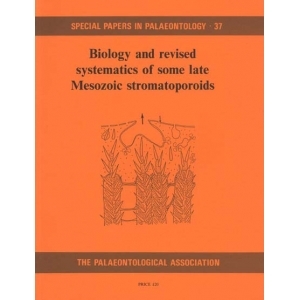
Special Papers in Palaeontology: 37
<br />1987
<br />
<br />Biology and revised systematics of some late Mesozoic stromatoporoids.
<br />R Wood
<br />
<br />89 pp., 7 pls.
<br />
<br />ABSTRACT. The presence of spicule pseudomorphs and an aquiferous filtration system in some late Mesozoic stromatoporoids (Bathonian-Hauterivian) confirms poriferan affinity for this previously problematic group. The form and postulated original siliceous nature of most of the spicules indicates that the possessors of these were calcified demosponges; others with originally calcareous spicules were calcareans. Different spicule types and arrangements indicate that the possession of a calcareous skeleton is a convergent feature. Characteristics previously considered diagnostic are found to be invalid and the term 'stromatoporoid' now only refers to a grade of organization of the calcareous skeleton and not a taxonomic grouping. 'Chaetetids', 'sphinctozoans' and 'sclerosponges' are also polyphyletic groupings, representing grades, in which some members are calcified demosponges. These groupings should no longer be considered in isolation, as this has previously obscured their true nature.
<br />A new taxonomic scheme is presented based on spicule type, arrangement, and relationship of this framework to the microstructure of the calcareous skeleton. On the basis of spicule criteria, calcareous microstructure alone is found to be convergent and can no longer be used as a high-level taxonomic feature. Spiculate species of late Mesozoic stromatoporoids are redescribed and placed within the Recent poriferan classification framework. Synonyms are documented and intraspecific variation discussed. The present cnidarian-based nomenclature is replaced by one modified from Recent poriferan terminology.
<br />Nine genera are redescribed within the Recent demosponge classification. The Burgundidae, which were probably aspiculate, are very tentatively placed in the Ceractinomorpha. Of the present sixteen species of Burgundia, five are eliminated from the genus and the remaining species are synonymized to three. Dehorne//a, Sleineria, Shuqraia, Promi//epora, Paraslromalopora, and Murania are placed in the family Milleporellidae, within the order Axinellida, in the Tetractinomorpha. ASlroporina is found to be a junior synonym of Dehorne//a, and A. sle//ifera, A. sle//ens, A. orienla/is, and A. cf. orienta/is are synonyms of D. cruslans. D. omanensis and ASlroporina sp. are found to be synonyms of D. harrarensis. S. heybroeki and S. arabica are found to be synonyms of S. zuffardi. A new species S. hudsoni is erected for material previously described by Hudson. The genus AClinoslromarianina is placed in a new family, the Actinostromarianinidae. The three species of Acloslroma described by Hudson are synonyms and are referred to A. damesini. The Actinostromarianinidae and the Actinostromariidae are also tentatively placed within the Axinellida.
<br />Analogies with Recent calcified demosponges suggests that the fossil stromatoporoid demosponges produced a primary framework of siliceous spicules bound together with an organic matrix, which probably provided the nucleation sites for subsequent precipitation of the calcareous skeleton.